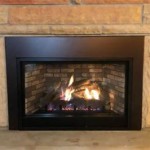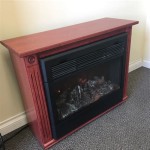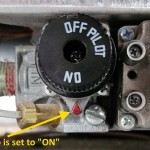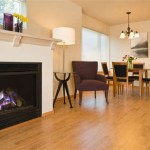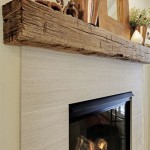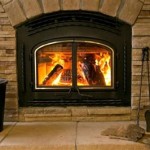Refacing a Brick Fireplace: A Comprehensive Guide
A brick fireplace, often a central feature of a living space, can become dated or clash with evolving interior design preferences. Refacing provides an effective alternative to complete demolition and reconstruction, offering a significant aesthetic update without the extensive labor and cost. This process involves covering the existing brick with a new material, effectively giving the fireplace a new facade.
Refacing a brick fireplace is a multifaceted project that requires careful planning, material selection, and execution. Factors such as existing fireplace condition, desired aesthetic, budget, and building codes all play a crucial role in achieving a successful outcome. This article provides a detailed overview of the process, covering essential considerations and practical steps.
Evaluating the Existing Fireplace Structure
Before embarking on any refacing project, a thorough assessment of the existing brick fireplace is paramount. This evaluation identifies potential structural issues that could compromise the integrity of the new facade. Key areas of focus include:
Brick Condition: Examine the brick for cracks, spalling (surface flaking), or loose mortar joints. Minor imperfections can often be addressed during the preparation phase, but significant damage may necessitate brick repair or even partial replacement before refacing. Spalling, often caused by moisture penetrating the brick and then freezing, can lead to structural weakening. If the affected areas are widespread, it’s crucial to determine the root cause of the moisture intrusion and rectify it before proceeding.
Firebox Integrity: The firebox, the chamber where the fire burns, requires a particularly rigorous inspection. Look for cracks in the firebrick lining, which is specifically designed to withstand high temperatures. Damaged firebrick can lead to heat transfer to surrounding combustible materials, posing a safety hazard. Firebox repairs often involve replacing damaged firebricks with new ones using refractory mortar. The firebox should also be checked for proper dimensions and clearances according to local building codes.
Smoke Chamber and Chimney Inspection: The smoke chamber directs smoke from the firebox into the chimney. Cracks or deterioration in the smoke chamber can impede proper drafting and increase the risk of smoke entering the living space. The chimney, which vents combustion gases, should be inspected for blockages, cracks, and the condition of the flue liner. A professional chimney sweep can perform a thorough inspection and cleaning, identifying any potential problems. Addressing chimney issues is critical for safe and efficient fireplace operation.
Clearances to Combustible Materials: Building codes mandate specific clearances between the fireplace and surrounding combustible materials, such as wood framing or drywall. These clearances minimize the risk of fire hazards. Ensure that the existing fireplace meets these code requirements or plan to modify the surrounding structure to achieve compliance. Checking local building codes is always advisable.
Addressing any structural deficiencies before refacing is crucial for ensuring the long-term stability and safety of the fireplace. Neglecting these issues can lead to costly repairs later and potentially compromise the safety of the home.
Selecting Refacing Materials and Design
The choice of refacing materials and design significantly impacts the overall aesthetic and functionality of the fireplace. A wide variety of options are available, each with its own advantages and disadvantages. Key considerations include:
Material Options:
- Stone Veneer: Stone veneer offers a natural, rustic appearance and is available in various styles, colors, and textures. It is relatively lightweight and easy to install compared to full-thickness stone. Both natural and manufactured stone veneers are available. Natural stone offers unique variations in color and texture, while manufactured stone provides consistency and a wider range of design options.
- Tile: Tile is a versatile option available in a vast array of colors, patterns, and sizes. It is durable, easy to clean, and can be used to create a contemporary or traditional look. Porcelain, ceramic, and glass tiles are all suitable for fireplace refacing. Consider the heat resistance of the tile, especially around the firebox opening.
- Brick Veneer: For a more subtle update, brick veneer can be used to create a cleaner, more modern brick facade. It is thinner and lighter than full-size bricks, making it easier to install. Brick veneer is available in various colors and textures, allowing for customization to match existing architectural styles.
- Wood: Wood can be used to create a warm and inviting fireplace surround. However, wood is a combustible material and must be installed with proper clearances from the firebox opening. Consider using non-combustible materials, such as cement board, behind the wood to provide a fire-resistant barrier.
- Concrete: Concrete is a versatile material that can be cast into various shapes and textures. It offers a modern and industrial aesthetic and can be stained or sealed to achieve different looks. Concrete can be used to create a seamless, monolithic fireplace surround.
Design Considerations:
- Style: Choose a style that complements the existing architecture of the home. Consider the overall design aesthetic of the living space and select materials and a design that seamlessly integrates with the existing decor.
- Scale: Ensure that the scale of the refacing materials is appropriate for the size of the fireplace and the room. Overly large materials can overwhelm a small fireplace, while overly small materials may appear insignificant in a large space.
- Color: Select colors that complement the existing color palette of the room. Consider the impact of light on the colors and choose shades that will create the desired ambiance.
- Texture: Texture can add visual interest and depth to the fireplace. Consider the texture of the refacing materials and how they will interact with the surrounding light.
- Hearth: The hearth, the non-combustible area extending from the fireplace opening, should be considered as part of the refacing design. It can be updated to match the new facade or to create a contrasting focal point. Hearth extensions must meet code requirements based on the size of the firebox opening.
It is advisable to create a detailed design plan, including sketches or renderings, before starting the refacing project. This plan will help visualize the final result and ensure that all materials and dimensions are properly accounted for.
The Refacing Process: Step-by-Step Guide
The refacing process typically involves several key steps. The specific procedures may vary depending on the materials used and the complexity of the design. However, the following provides a general overview:
Preparation:
- Cleaning: Thoroughly clean the existing brick surface to remove dirt, dust, and any loose mortar. Use a wire brush and a masonry cleaner to prepare the surface for adhesion.
- Surface Preparation: Apply a bonding agent to the brick surface to improve adhesion of the new materials. A polymer-modified mortar or a similar product specifically designed for bonding to masonry is recommended.
- Leveling: Address any uneven surfaces or imperfections in the brick. Use mortar or a patching compound to create a level and even surface for the refacing materials.
- Protection: Protect surrounding areas with drop cloths and masking tape to prevent damage from mortar or other materials.
Installation:
- Mortar Application: Apply mortar to the back of the refacing materials using a notched trowel. Ensure that the mortar is evenly distributed and provides sufficient coverage.
- Material Placement: Carefully position the refacing materials on the brick surface, pressing firmly to ensure proper adhesion. Use spacers to maintain consistent joint widths.
- Cutting and Shaping: Cut and shape the refacing materials as needed to fit around the firebox opening and any other architectural features. Use appropriate tools, such as a wet saw or a tile cutter, to achieve clean and precise cuts.
- Leveling and Alignment: Regularly check the level and alignment of the refacing materials to ensure a uniform and aesthetically pleasing result. Use shims or wedges to make adjustments as needed.
Finishing:
- Grouting (for Tile or Stone): Apply grout to the joints between the refacing materials. Choose a grout color that complements the materials and the overall design.
- Sealing: Seal the refaced fireplace to protect it from moisture and stains. Use a sealant specifically designed for the refacing materials.
- Cleaning: Clean the refaced fireplace to remove any excess mortar, grout, or sealant. Use a soft cloth and a mild cleaner to avoid damaging the surface.
- Caulking: Apply caulk around the firebox opening and any other areas where the refacing materials meet adjoining surfaces. Use a heat-resistant caulk specifically designed for fireplaces.
Safety Precautions:
- Wear appropriate safety gear, including gloves, eye protection, and a dust mask.
- Work in a well-ventilated area.
- Follow the manufacturer's instructions for all materials and tools.
- Consult with a professional if you are unsure about any aspect of the refacing process.
Refacing a brick fireplace is a rewarding project that can significantly enhance the aesthetic appeal of a home. By carefully planning the project, selecting appropriate materials, and following proper installation techniques, homeowners can achieve a stunning and long-lasting transformation.

A Step By Guide To Fireplace Refacing Diy Family Handyman

Reface A Fireplace With The Look Of Stone Or Brick Barron Designs

Our Transformed Fireplace Before After Reface Diy Update

Debbie Travis Update Your Fireplace By Refacing The Surround Victoria Times Colonist

15 Fabulous Fireplace Refacing Ideas Average But Inspired

Stone Fireplace Refacing Reface Brick Selex

16 Red Brick Fireplace Makeover Ideas

15 Fabulous Fireplace Refacing Ideas Average But Inspired

10 Fireplace Makeover Ideas Before And After Regency

16 Red Brick Fireplace Makeover Ideas
Related Posts

